Community Tip - Stay updated on what is happening on the PTC Community by subscribing to PTC Community Announcements. X
- Subscribe to RSS Feed
- Mark Topic as New
- Mark Topic as Read
- Float this Topic for Current User
- Bookmark
- Subscribe
- Mute
- Printer Friendly Page
limit problem in mathcad 15
- Mark as New
- Bookmark
- Subscribe
- Mute
- Subscribe to RSS Feed
- Permalink
- Notify Moderator
limit problem in mathcad 15
I use mathcad 15 M020 to quest the limitation of:
(1+2^n+3^n)^(1/n), n-->infinity
and the answer should be 3, but in mathcad it seem can not calculate it.
and I try it on the Prime M010, false too.
Why? and How should I solve this problem?
My pc system is Win7 ultimate.
Solved! Go to Solution.
- Labels:
-
Other
- Mark as New
- Bookmark
- Subscribe
- Mute
- Subscribe to RSS Feed
- Permalink
- Notify Moderator
Did you take the wrong expression or is the "1/" cut off from the screenshot?
But I doubt the result anyway - all values being 32????
- Mark as New
- Bookmark
- Subscribe
- Mute
- Subscribe to RSS Feed
- Permalink
- Notify Moderator
Use maple to plot this function like this:

- Mark as New
- Bookmark
- Subscribe
- Mute
- Subscribe to RSS Feed
- Permalink
- Notify Moderator
Werner Exinger wrote:
Did you take the wrong expression or is the "1/" cut off from the screenshot?
But I doubt the result anyway - all values being 32????
Yes is cut off from the screeenshot. if k = 100 then s(k)= 64
- Mark as New
- Bookmark
- Subscribe
- Mute
- Subscribe to RSS Feed
- Permalink
- Notify Moderator
f(100)=100, OK?
- Mark as New
- Bookmark
- Subscribe
- Mute
- Subscribe to RSS Feed
- Permalink
- Notify Moderator
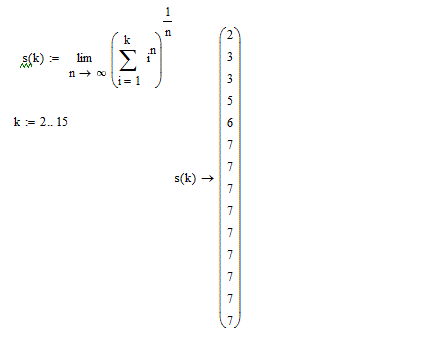
- Mark as New
- Bookmark
- Subscribe
- Mute
- Subscribe to RSS Feed
- Permalink
- Notify Moderator
Now its getting really funny.
I did it in Derive and the result is always k, so far. beginning from k=6 I had to use numeric approximation as Derive could not simplify the resluting expression.
Whats going on here.
I don't know how to evaluate that limit manually, but Derive's results look reasonable.
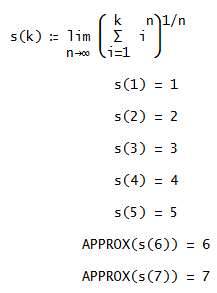
- Mark as New
- Bookmark
- Subscribe
- Mute
- Subscribe to RSS Feed
- Permalink
- Notify Moderator
Yes is strange.I checked and Mathcad shows bad results.
- Mark as New
- Bookmark
- Subscribe
- Mute
- Subscribe to RSS Feed
- Permalink
- Notify Moderator

- Mark as New
- Bookmark
- Subscribe
- Mute
- Subscribe to RSS Feed
- Permalink
- Notify Moderator
Jan Kowalski 编写:
I think you have meet the next mathcad problem, mathcad's calculation precision is 10^17 (if you have chosen the high precision pattern in the "tool" menu), that is mathcad can only display and calculate the front 17 number of a long digits number when the "float" symbolic function disabled.

Several days ago, I used to solve Project Euler by mathcad, and meet this problem when I calculate 2^1000 and 100! (the problem 16 and 20), mathcad can't solve its, even I use "float" symbolic funcion as " float,250 --->" (250 is the maximum digit that "float" can display). But I have already solve that 2 problem by using trunc() function and "float". ![]()
- Mark as New
- Bookmark
- Subscribe
- Mute
- Subscribe to RSS Feed
- Permalink
- Notify Moderator
Dont confuse symbolic and numeric evaluation. These are completely different sections in Mathcad.

The symbolics is not limited to 17 decimal places and does not face the upper limit of 10^307 (which in fact is 1.797..*10^308 (= 2^1024 - 1)). A limit one sometimes can overcome using logarithms (see: http://communities.ptc.com/message/195099#195099) but I don't think that this would be a solution here.
The limits for the smbolics are not known to may (display is up to 250 places, but in doung symbolics you should not use float anyway). It would be good if symbolics would work internally with integers only (as e.g. Derive does). So the limits are insatlled/usable memory and your patience only. This seems not to be the case with muPad (the symbolic engine in Mathcad).
I try to summarize here:
There is a limit consisting of a couple of summands and a root which
- for three summands is symbolically calculated correectly on some installations of Mathcad 15 M020 and is not evaluted at all on other installtions. Same version and maintainance release
- beginning from four summands, on the installations which work for three Mathcad mathcad delivers wrongs results for some/most number of summands (4, 8-15,....).
Neverteless I won't open a case at PTCs submit page as of bad experiences with that. In the past when reporting an error there where three diferent reactions possible:
- being called back (very quickly) by a (very friendly) person with obviously minor mathematical/programming knowledge which, after a second call back assured me that the error is already known and will be addresed in the next maintainance release (which it was not, but it was later in MC15).
- After submitting screenshot and worksheet for everybody to reproduce the error the person on the phone (callback again) tried to talke me insisting to participate in a kind of video chat with another person. My spoken English being less than mediocre and feeliong very uncomfortable to do so I refused. There was no reason to talk anyway as the sheet and screenshot shows clearly the error.
- No reaction at all.
- Mark as New
- Bookmark
- Subscribe
- Mute
- Subscribe to RSS Feed
- Permalink
- Notify Moderator
Werner Exinger 编写:
Dont confuse symbolic and numeric evaluation. These are completely different sections in Mathcad.
The symbolics is not limited to 17 decimal places and does not face the upper limit of 10^307 (which in fact is 1.797..*10^308 (= 2^1024 - 1)). A limit one sometimes can overcome using logarithms (see: http://communities.ptc.com/message/195099#195099) bu I don't think that this would be a solution here.
What you say and the link is very useful for me! Thank you very very much. Yes, I do with the huge number ever used a wrong method. Sorry to disturbing you sir.
I use MuPad calculate this limit problem, the result is just the same as in mathcad, f(4)=3, f(8)=7, and f(100)=64. Seemly MC and Mupad have the same symbolic computing program.
It is almost a pity about mathcad & Mupad, maybe the better method to solve this matter (it's only a trick and really not very important to engineering work) is to run it on a more acdemic math program.
Today I have learn a lot from here, thank you again. ![]()
- Mark as New
- Bookmark
- Subscribe
- Mute
- Subscribe to RSS Feed
- Permalink
- Notify Moderator
What you say and the link is very useful for me! Thank you very very much. Yes, I do with the huge number ever used a wrong method. Sorry to disturbing you sir.
You are welcome, Zhu! No problem, no disturbing anyway
Seemly MC and Mupad have the same symbolic computing program.
Yes, Mathcad people (formerly Mathsoft, now PTC) have licensed muPad to use as their symbolic engine. Its the same engine working in Matlab (they own muPad now, though). In versions prior to 14 the symbolic engine included with Mathcad (and BTW Matlab, too) was Maple and many users regret that switchover to muPad.
But I don't think that PTC plans to change that . Prime includes muPad as well and shows the same errors.
Today I have learn a lot from here,
Me too, and I still wonder why the limit with threee summands evaluates for some (most?) people and for some (me and you) not. 😞
- Mark as New
- Bookmark
- Subscribe
- Mute
- Subscribe to RSS Feed
- Permalink
- Notify Moderator
Another problem with Mathcad(15 and Prime 2) is unable to calculate the limit.
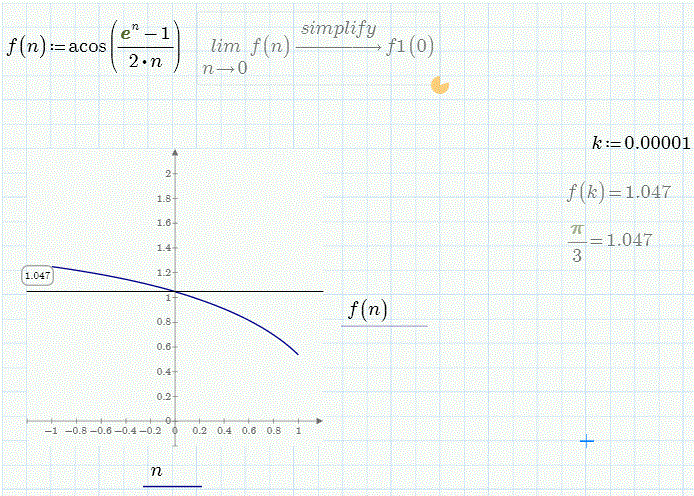
I'm waiting I'm waiting, and nothing.![]()
![]()
- Mark as New
- Bookmark
- Subscribe
- Mute
- Subscribe to RSS Feed
- Permalink
- Notify Moderator
Jan Kowalski wrote:
Another problem with Mathcad(15 and Prime 2) is unable to calculate the limit.
I'm waiting I'm waiting, and nothing.
Yes, the other way round is easier 😉

- Mark as New
- Bookmark
- Subscribe
- Mute
- Subscribe to RSS Feed
- Permalink
- Notify Moderator
I have one friend - one mathematics teacher at my university. She has a hobby - collecting mathematical problems that she can solve but mathematical packages (Ma..., Ma..., Ma..., Ma..., Ma...) cannot solve.
She is very upset when one package together with one professional is certainly able to solve one of her problems from the collection. ![]()
- Mark as New
- Bookmark
- Subscribe
- Mute
- Subscribe to RSS Feed
- Permalink
- Notify Moderator
The original limit here works ok for me in M15, but doesn't in Prime 2. Prime also produces another interesting (and incorrect) result for an equivalent variant:
Alan
- Mark as New
- Bookmark
- Subscribe
- Mute
- Subscribe to RSS Feed
- Permalink
- Notify Moderator
Good work Alan! You have find a really very very good solution!

- Mark as New
- Bookmark
- Subscribe
- Mute
- Subscribe to RSS Feed
- Permalink
- Notify Moderator
- Mark as New
- Bookmark
- Subscribe
- Mute
- Subscribe to RSS Feed
- Permalink
- Notify Moderator
朱 欣研 wrote:
Good work Alan! You have find a really very very good solution!
That workaround is really interesting, but when / where has Alan posted it? I can't see his post.
Has anybody an idea why the limit eavluates for some of s (correct with three summands at least) and does not evaluate for others?
My first guess that installed memory could be the cause seems to be false as I just tried it on two different machines with Win764bit and 4 & 8 GByte of memory and it did not evaluate, too. So what else could be the cause? The localized Windows? Don't think so. The localized Mathcad? I am using a German version but am usually working with menu language and math language to English because of some other problems I run into if switching them to German.
- Mark as New
- Bookmark
- Subscribe
- Mute
- Subscribe to RSS Feed
- Permalink
- Notify Moderator
Hi Werner:
Alan's and your function enlighten me, the picture is from my solution worksheet that has been upload there. But it calculate very slowly, can't calculate F(100) on my computer. I try to plot F(n) at maple, and Maple can't do it.
I use Chinese version, it seem have nothing to do with the version of Windows or mathcad. An enigma it is.
Zhu
- Mark as New
- Bookmark
- Subscribe
- Mute
- Subscribe to RSS Feed
- Permalink
- Notify Moderator
Why not just use F(n) = n? Alan's augmented formula shows why only the last term is important, and it simplifies to n. The lesser terms are fractions which go to zero as i-> infinity.
The root numerical methods will not compute for large n due to the 10^307 limit on number size.
Message was edited by: Harvey Hensley changed to i going to infinity
- Mark as New
- Bookmark
- Subscribe
- Mute
- Subscribe to RSS Feed
- Permalink
- Notify Moderator
Well Harvey, what you say really simplify this problem, and fasten the worksheet's calculation speed.
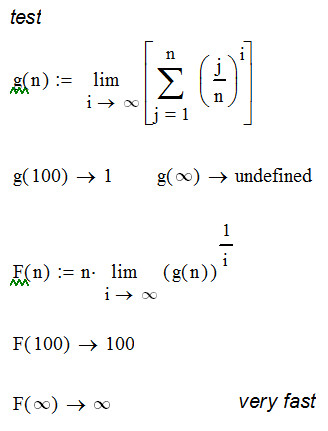
and if I use infinity directly instead of using limitation function, the result is like Alan's

and it's very interesting that play in maple, no one is right, except use real number:
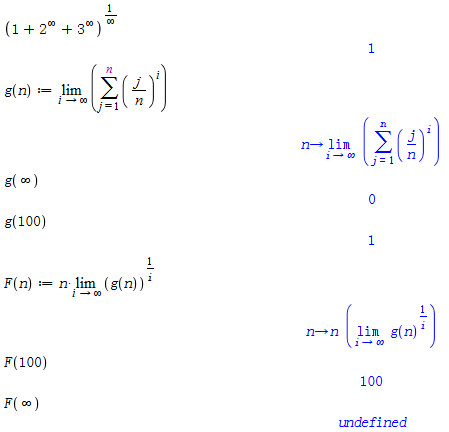
- Mark as New
- Bookmark
- Subscribe
- Mute
- Subscribe to RSS Feed
- Permalink
- Notify Moderator
I use Chinese version, it seem have nothing to do with the version of Windows or mathcad.
Its only a guess as I cannot image something else. I'm simply looking for difference. As far as I know there are plain English versions and localized versions of Mathcad. In the latter you can switch the math language and the menu language between your language and english. So thats a a difference. Of course this should not affect evaluation of expressions, but who knows. On the other hand - Valery had provided a screenshot and it is clearly seen that the limit evaluated fo him and I guess he is using a russian/english version.
So I am clueless as in the beginning. 😞
- « Previous
-
- 1
- 2
- Next »







